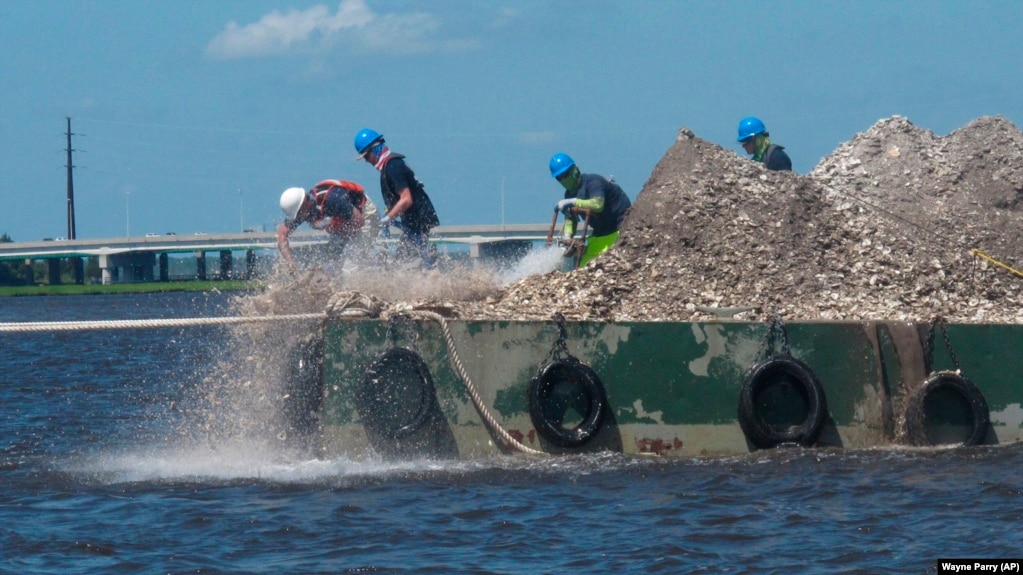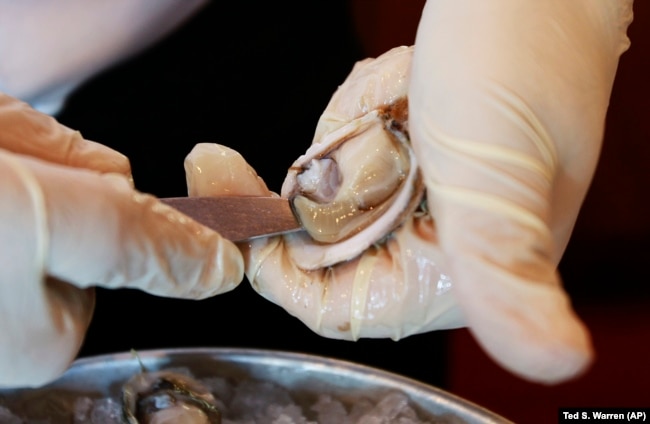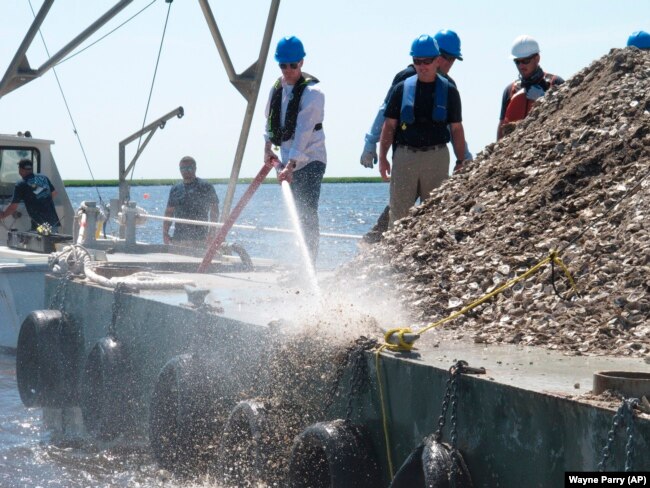
In this June 29, 2021 photo, workers on a large flat boat (called a barge) put 680 bushels of clam and oyster shells into the Mullica River in Port Republic, New Jersey. (AP Photo/Wayne Parry)
When we eat some popular kinds of shellfish, namely clams, mussels and oysters, we leave behind large amounts of shells.
Instead of throwing these shells into the trash, several projects around the United States now aim to put these shells back into waterways. The goal is to restore, or bring back, the natural environment a process called ecological restoration.
In his article for The Associated Press, writer Wayne Parry describes this restoration as “the seafood circle of life.”
In the U.S. and around the world, shells discarded at restaurants and other businesses are being collected, cleaned and thrown back into waterways. The shells form a base for new colonies of sea creatures and help to protect coastlines.

To shuck an oyster is to remove the meat from inside the shell.
One of the latest projects with oysters takes place in Atlantic City, New Jersey. Some businesses there save the shells. The state’s Department of Environmental Protection, or DEP, collects them. Then, workers and volunteers with Rutgers and Stockton universities cooperate with the Jetty Rock Foundation to load them onto boats and put them into the state’s Mullica River.
Those shells go back into the water to help form new or expanded oyster colonies. Free-floating baby oysters, known as spat, connect to the shells and grow on them.
The Mullica River is home to one of the last self-sustaining oyster populations on the Atlantic coast, said Shawn LaTourette. He is New Jersey’s leading environmental official.

New Jersey Environmental Protection Commissioner Shawn LaTourette, left, uses a high-pressure hose to send clam and oyster shells into the Mullica River in Port Republic, New Jersey, June 29, 2021. (AP Photo)
Scott Stueber is a fish biologist with the Department of Environmental Protection. He told the AP the ecological restoration project has already kept about 60,000 kilograms of shells out of landfills. It has also helped eateries save money on discarding their shells.
The Mullica River project began in 2019. It aims to grow oysters for ecological purposes. However, it is also being studied as a possible commercial harvesting site in the future, the DEP said.
How does this help?
While these projects do create new places to harvest and sell oysters for food, the main goal is to help improve the environment.
In nature, oysters are cleaners. One adult oyster can remove pollutants from about 190 liters of water a day. So, experts say they can improve water quality.
Oyster colonies also are being planted along some coastlines to strengthen shores. This protects against ocean storms and rising waters. Underwater, oyster colonies can weaken destructive waves headed for the shoreline.
The Global Center on Adaptation explains on its website how oyster reefs can protect shorelines. Such reefs can also create homes for other sea life and provide food for humans. On its website, the organization describes ecological restorative efforts in Bangladesh.
Communities, environmental groups and governments around the world have used oyster recycling and replanting in recent years. In the U.S., it is happening in other states.
Each year in Maryland, the Chesapeake Bay Foundation turns 70 cubic meters of recycled shells a year into oyster colonies.
Since 2009, the Harte Research Institute at Texas A&M University has collected about 800,000 kilograms of shells and restored about 100,000 square meters of oyster reef.
Since 2015, New York’s Billion Oyster Project has collected about 726,000 kilograms of shells from 75 restaurants. The organization has planted 13 oyster reefs across New York Harbor.
There are similar projects in the U.S. states of Florida and Massachusetts, as well as in the Netherlands and Australia.
Words in This Story
ecological restoration – n. the process of assisting the recovery of an ecosystem that has been degraded, damaged, or destroyed.
discard – v. to get rid of especially as useless or unwanted
self-sustaining – adj. maintaining or able to maintain oneself or itself by independent effort
landfill – n. an area where waste is buried under the ground
commercial – adj. related to or used in the buying and selling of goods and services
reef – n. a chain of rocks or coral or a ridge of sand at or near the surface of water
recycle – v. to pass again through a series of changes or treatments: such as
Comprehension Quiz
1. What is the story mainly about?
2. Where does one of the latest projects with oysters take place?
3. Who is Shawn LaTourette?